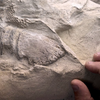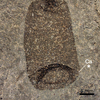How to find a Dinosaur Tooth

If you're looking to find an authentic dinosaur fossil, your first thought might be to check a history museum. While you certainly can find some great specimens there, getting a fossil of your own might be easier than you'd think. As it turns out, it's all about where you look.
The iconic Spinosaurus, a semiaquatic dinosaur named for its massive neural spines, first entered the fossil record 99 million years ago. Over the course of about 7 million years, the species thrived as the top predator in its aquatic hunting grounds. With long jaws full of sharp conical teeth, the Spinosaurus was built for ambushing fish and marine reptiles.
These specialized teeth are how we know so much about Spinosaurus today. While skeletal pieces of the animal are extremely rare, the teeth can be quite abundant in the fossil beds of its former habitat.
There are a few factors for this; first is how many teeth a single Spinosaurus would have in its lifetime. A full sized Spinosaurus is estimated to have carried 64 teeth between its crocodile-like jaws. Between fights and feeding, teeth were prone to breaking and falling out. Research suggests that these missing teeth would be regrown in periods as quick as 60 days, meaning the dinosaur was able to get a full set of chompers back in no time.
While a single Spinosaurus could supply plenty of teeth on its own, there were many members of the species alive at one time. Over the course of 7 million years on Earth (orders of magnitude longer than human civilization), there ends up being millions upon millions of teeth from this amazing dinosaur. Only a small percentage of these teeth would become properly fossilized, but even a sliver of such a prolific amount means there are likely hundreds of thousands of tooth fossils waiting to be discovered!
That's not to say that it's an easy task to find a dinosaur tooth. Paleontologists still have their work cut out for them. Even with a large amount of teeth in the fossil record, finding where they are and digging them out presents a challenge of its own. Even after, a fossil hunter must be careful to identify and clean the tooth without damaging it.
These teeth tell us so much about the amazing dinosaur. From the shape and placement of them, we've learned about the Spinosaurus' diet and hunting tactics. In fact, a 2020 find of over 1,200 teeth in Moroccan fossil river beds lead paleontologists to realize the Spinosaurus likely led an even more aquatic lifestyle than previously thought.
If you're looking to start your own collection of dinosaur fossils, a Spinosaurus tooth is the perfect place to start. These teeth are recognizable and affordable collectables from an iconic dinosaur and are fascinating to study in the palm of your hand! Check out Mini Museum's collection of teeth to learn more about the Spinosaurus and start your Dinosaur Museum today!
Featured Product
Joe Frazier Boxing Glove
Cool Things!

Is “Paul is Dead” Dead?: Unpacking One Of Pop Culture’s Most Enduring Conspiracy Theories

Scientists Discover Hooves and Skin in Preserved Dinosaur "Mummies!"
A dinosaur discovery just in time for Halloween! In a new analysis of a group of fossils from Wyoming, Scientists have determined this group of fossils are dinosaur “mummies,” with preserved skin and even hooves.

Scientists Record a Bat Catching Birds Mid-Flight!
Bats, birds, screeches, oh my! In a reverse-Hitchcock twist, a new study reveals that a species of European bat catches and eats birds mid-flight.
Specimen Deep Dives

The House that Ruth Built: The Story of the Old Yankee Stadium

The Queen of the Skies: the Story of the Boeing 747

Old Ironsides: The USS Constitution and the Start of the U.S. Navy
Long Form Articles

The Artist Behind the Macintosh: Susan Kare and Apple Computers
While the two Steves, Jobs and Wozniak, are the most well known faces behind Apple computers, equally important to the products and culture of the company were those who crafted the experience of using their computers through design. The most notable of these visual architects was Susan Kare, a designer responsible for “humanizing” Macintosh computers.

Can I Lick It? Yes You Can!
Have you ever been unable to tell if a fossil was really a fossil, but you were too embarrassed to admit it? Have you ever wanted to lick a fossil just because, but you didn’t want to risk judgment from your peers? Well, good news! You can kill two birds with one stone! Licking a fossil can actually help you determine if it’s the real deal or just another rock.

Is It Legal To Own a Meteorite: How to Start Your Outer Space Collection!
Meteorites are some of the rarest geological specimens to be found on Earth. Of course, since these stones are not of our world, purchasing them can sometimes be a confusing process. Is it legal to own a meteorite? In short, yes! Read on for help starting your cosmic collection!



















